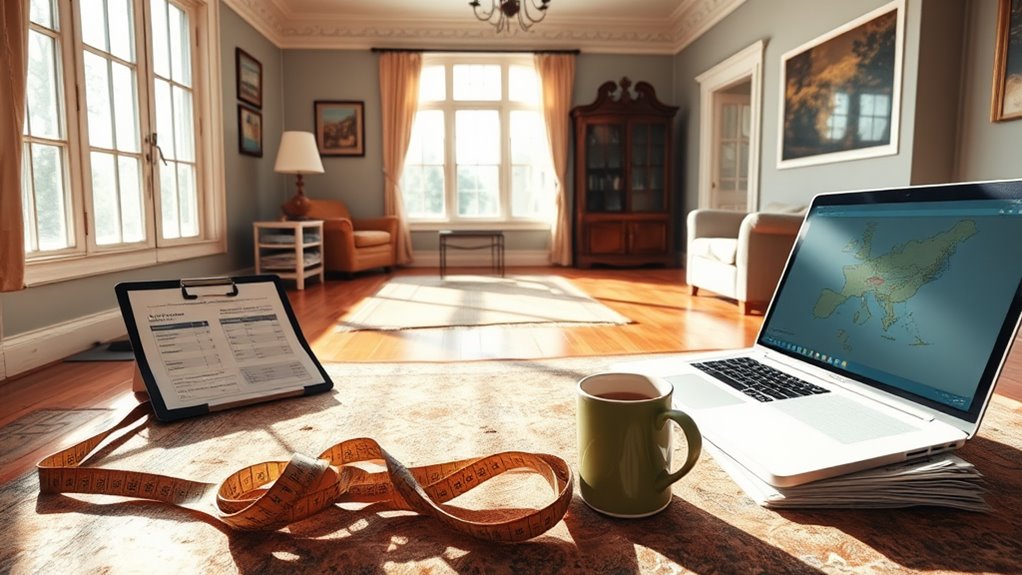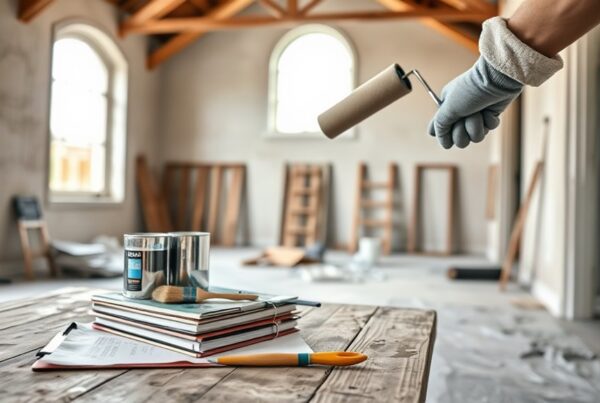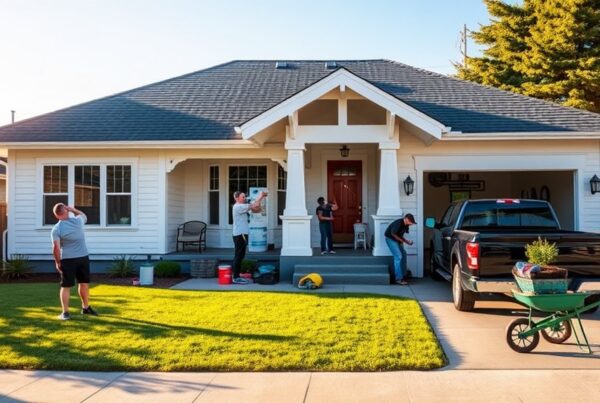To flip a house with $40k, focus on undervalued properties in distressed areas and use the 70% rule to guarantee profitability. Secure financing through hard money loans or partnerships, allocating 10-20% for unexpected costs. Partner with experienced investors for insights and funding. Prioritize high-impact, cost-effective renovations like kitchen and bathroom upgrades. Conduct thorough market research to set a competitive price and leverage strategic marketing to sell. Discover how these steps can turn your $40k into a profitable flip.
Key Takeaways
- Target distressed properties in high-demand areas to maximize potential returns on a $40k budget.
- Secure hard money loans or private investors to cover up to 65% of the ARV with minimal down payment.
- Focus on cost-effective renovations, prioritizing kitchens and bathrooms for strong ROI.
- Stick to a detailed budget, allocating 10-20% for unexpected expenses to avoid overruns.
- Sell during peak seasons with professional staging and marketing to maximize profitability.
Identifying Undervalued Properties for Flipping
To identify undervalued properties for flipping, start by targeting areas with a high concentration of distressed homes, as these often sell below market value, offering strong profit potential. Distressed properties are typically sold at a discount due to neglect, foreclosure, or financial hardship, making them ideal for real estate investing. Use the 70% rule to assess profitability: verify your total expenses, including purchase price and renovations, don’t exceed 70% of the property’s after-repair value (ARV). Leverage online platforms like Zillow or Redfin to find listings that have been on the market for extended periods, as these may be undervalued and negotiable. Additionally, attend local auctions and foreclosure sales, where distressed properties are often available at lower prices. Build relationships with agents specializing in investment properties, as they can provide access to off-market opportunities and insights into market trends. Consider exploring tax defaulted auctions for steep discounts on properties, similar to land flipping strategies. Stay strategic to secure a good deal.
Securing Financing and Budget Allocation
To secure financing for your flip, explore hard money loans, which typically fund up to 65% of the ARV while requiring a 20-25% down payment, so focus on properties priced within your budget like $160k. Allocate your budget strategically by earmarking 10-20% of your rehab costs as a contingency fund to manage unexpected expenses. Factor in additional costs such as agent commissions, marketing, and closing fees, ensuring they don’t exceed 6-10% of the purchase price to maintain profitability. Remember to apply the 70% rule to ensure your total investment doesn’t surpass 70% of the property’s ARV.
Financing Options
Securing financing and allocating your budget strategically are critical steps in successfully flipping a house. With $40k, you can leverage hard money loans by putting down 20-25%, enabling you to purchase a property with a higher purchase price while preserving funds for renovations. Calculate the maximum purchase price using the formula: ARV – 30% – estimated renovations. Private money lenders or partners can also provide additional capital, often in exchange for a share of the profits. Always include a contingency fund of 10-20% of renovation costs to manage unexpected expenses. Hard money loans are ideal for fix-and-flip projects, offering quick approval and flexibility tailored to specific project needs. Below is a breakdown of financing options for flipping homes:
| Option | Down Payment | Key Benefit |
|---|---|---|
| Hard Money Loan | 20-25% | Quick approval, higher leverage |
| Private Money | Varies | Flexible terms, shared risk |
| Personal Savings | 100% | No interest or reliance |
| Partnerships | Shared | Access to additional capital |
| Bank Loan | 20-30% | Lower interest rates |
Budget Planning
When planning a house flip with a $40,000 budget, you’ll need to allocate funds meticulously across purchase price, renovations, and unforeseen expenses. Start by identifying a property that fits within your budget, leaving ample room for necessary renovations and closing costs. Hard money loans can help by covering up to 65% of the After Repair Value (ARV), reducing upfront cash requirements. Create a detailed rehab budget, accounting for material and labor costs, and set aside 10-20% for unexpected expenses to avoid overruns. Don’t overlook additional costs like property taxes or agent commissions, as they can erode profits. Leverage partnerships with experienced investors or family and friends to supplement your cash reserves, ensuring you stay within your $40,000 limit while maximizing potential returns.
Partnering With Experienced Investors or Lenders

While flipping a house, aligning with experienced investors or lenders can greatly enhance your project’s potential for success. Partnering with experienced investors allows you to tap into their deep understanding of the flipping game, helping you identify profitable deals and streamline renovations. By leveraging private money investors, you can secure 100% funding for your project, preserving your $40k for renovations while sharing profits based on a predetermined structure. Hard money lenders offer another strategic option, providing quick financing with minimal down payments—typically 20-25%—and funding up to 65% of the after-repair value. Networking with seasoned flippers can also lead to lucrative partnerships; you can earn finders fees or profit-sharing agreements by assisting with lead generation, negotiations, or marketing. These collaborations not only mitigate financial risk but also provide access to invaluable expertise, positioning you for greater efficiency and profitability in your flipping endeavors. It is essential to assess financial stability of all parties involved to ensure the success of your partnership and the overall project.
Planning and Executing Cost-Effective Renovations
You’ll maximize ROI by prioritizing high-impact upgrades like kitchens and bathrooms, which consistently yield strong returns. Allocate your renovation budget strategically, reserving 10-15% for unexpected costs to avoid financial strain. Negotiate contractor rates by gathering multiple quotes and emphasizing competitive pricing to ensure quality workmanship without overspending. Focus on cosmetic updates to minimize costs while enhancing property value significantly.
Budget Allocation Tips
Allocating your house-flipping budget effectively guarantees you maximize returns while minimizing unnecessary expenses. Start by dedicating 30-40% of your $40k to essential renovations like kitchens and bathrooms, as these areas greatly boost resale value. Set aside 10-15% for unexpected expenses to cushion against unforeseen renovation costs, ensuring your project stays on track. Allocate funds for high-impact upgrades such as modern fixtures and energy-efficient appliances, which attract buyers without overspending. Utilize cost-saving measures like obtaining multiple contractor quotes and DIY projects where feasible. Stick to a strategic plan to avoid overspending while achieving a polished, market-ready home. Understanding After Repair Value is crucial for accurate budgeting and ensuring profitable investments.
- Peace of mind: Reserve funds for contingencies—you’ll sleep better knowing you’re prepared.
- Smart spending: Focus on upgrades that buyers notice and value immediately.
- Stress reduction: Avoid budget overruns by planning meticulously from the start.
Prioritize High-Impact Upgrades
Three key strategies can help you prioritize high-impact upgrades when flipping a house. First, focus on renovations with the highest return on investment, such as kitchen upgrades, which can recoup around 80% of their cost. Second, address cosmetic improvements like fresh paint or new flooring, which are cost-effective yet dramatically enhance buyer appeal. Third, invest in bathroom remodels, as minor updates here yield up to a 70% return, making them a strategic choice for resale value. Additionally, boost curb appeal with landscaping or exterior upgrades to attract buyers and increase perceived value. Always allocate 10-20% of your budget for contingency costs, as unexpected expenses are common during renovations. By prioritizing high-impact upgrades and adhering to the 70% rule, you maximize returns while minimizing unnecessary spending.
Negotiate Contractor Rates
Negotiating contractor rates is a critical step in guaranteeing your house flip remains cost-effective. Start by researching local market rates to establish a baseline and identify areas where you can negotiate. Obtain multiple quotes to leverage competition and secure the best value. Build rapport with contractors through clear communication; this can often lead to discounted rates or favorable terms. Discuss cost-saving measures, such as alternative materials or reduced scope, to keep repairs within budget without compromising quality.
- Save thousands by negotiating upfront rates and avoiding overpayments.
- Maximize your budget by focusing labor costs on high-value repairs.
- Build relationships that yield long-term savings on future projects.
Finally, handle smaller tasks yourself or hire a handyman to reduce labor expenses. This strategic approach guarantees you maximize value while staying within your $40k budget.
Conducting Market Research for Maximum ROI

Why is thorough market research essential for achieving a 20% ROI in house flipping? Real estate investors rely on detailed market research to identify neighborhoods where the after-repair value (ARV) aligns with their target return on investment. Start by analyzing local trends, including average home prices and sales volume, using platforms like Zillow or Redfin to gather comparable sales data. Investigate demographic and economic factors, such as job growth and school ratings, as these drive buyer demand and property values. Leverage tools like the MLS to track days on market and price reductions, pinpointing undervalued properties. Attend local investor meetups to gain insights from experienced flippers about market opportunities. Accurate research minimizes risks and guarantees you purchase properties with the highest potential for profit. Without this groundwork, you risk overpaying or underestimating costs, jeopardizing your ROI. Strategic market analysis is the foundation of a successful flip.
Selling the Property for Optimal Profit
To guarantee maximum profitability when flipping a house, you’ll need a strategic approach to selling the property. Start with a thorough market analysis to set a competitive listing price, ensuring it reflects your repair value while leaving room for profit. Work with experienced real estate agents who understand local trends and can help you attract serious buyers. Staging the property and investing in professional photography will enhance its appeal, making it easier to sell for a great deal. Timing is critical—list during peak seasons like spring or summer to capitalize on higher demand.
- Imagine walking away with a significant return on your investment.
- Picture a buyer falling in love with your meticulously staged home.
- Feel the satisfaction of closing a deal that reflects your hard work and vision.
Use online listings, social media, and open houses to maximize exposure. Be prepared to negotiate, staying flexible on terms while safeguarding your profit margins.
Conclusion
You’ve got your blueprint—identify undervalued gems, secure smart financing, and partner with seasoned pros. Plan renovations meticulously, keeping every dollar laser-focused on maximizing ROI. Market research is your compass; it guarantees you sell at the peak of demand. With $40k, you’re not just flipping a house; you’re building a ladder to higher profits. Stay sharp, keep your eyes on the prize, and let your strategy be your guiding star.




